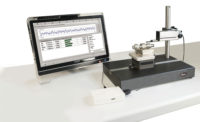TRAINING TRENDS: Caring for your Surface Plates increase the life of surface plates.


Surface plates have many uses. A surface plate is the “0“ reference point. If a height gage is used on the plate, the operator must “0“ that gage anywhere on the plate with a gage block. Remove the gage block and check a part to see if it is flat. However, this is mostly for small parts in mass production. Most automotive manufacturers use the plate to check for warp age of a chassis or crankshaft, as does the aircraft industry and other industry sectors. The usage is unlimited. Not only are the plates used in final quality control inspections but also throughout an entire plant as parts are being manufactured. Regardless of what piece of equipment is used to perform the daily work, individual parts are checked in manufacturing, and the finished product was probably checked before the final inspectors put their stamp of approval on it.
After years of using a plate, a quick way to check to see that the plate is maintaining its accuracy is to periodically test it with a repeat reading gage with a manual indicator. With this equipment, all that is required is to set the gage on the plate and zero it at any point on the table. Simply move the gage over the plate and if there are hand movements in the indicator more than 0.000025 inches for an “AA“ plate, 0.00005 inches for an “A“ plate or 0.0001 inches for a “B“ grade plate, then there is an indication that the surface plate may have some high and low spots and be out of tolerance. The tolerance must repeat from side to side within the specified tolerance range to be a good plate. If the plate proves to be out of the tolerance range there are relapping service companies throughout the United States that offer a calibration and relapping service in the customer's facility. A plate should be calibrated on an established cycle, typically one, two or three years depending on use.
Care and maintenance
The granite surface plate is a precision piece of equipment and must be properly installed and maintained. The following instructions should be carefully followed to assure maximum accuracy and durability.Be sure the granite surface plate is supported on the support system that comes furnished with the plate. The support system is normally a hard rubber pad that is attached to the bottom of the plate that forms a non-distortable three-point support system. The pads are installed during manufacturing, and the plate rests on them throughout lapping, inspection and shipping. The pads are a critical factor in surface-plate accuracy and must not be removed. Plates up to 6 feet by 12 feet are furnished with this non-distortable three-point support system. When mounting the plate on a stand, be sure that only the pads are resting on the stand. Users should never support the plate by the ledges, if it has ledges, or under its four corners. Supporting the plate in any manner other than the support system furnished with the plate will void the guarantee of accuracy.
Plates larger than 6 feet by 12 feet are supported on multiple support points, typically six or more points, that consist of granite pedestals and leveling wedges. The number of support points and positioning is determined by the size of the plate. The height of the granite pedestals, or whether they are used, is determined by the thickness of the plate and the overall working height desired. A set of instructions and a diagram showing the support point location comes with the plate.
Do not move or lift a granite surface plate with a forklift by placing the metal forks against the granite. Always have protective padding between the metal forks and the granite. Preferably, use nylon slings to move it.

Do not use granite surface plates as workbenches or lunch tables. Dropping wrenches or hammers on a granite surface plate can chip or nick the surface. Spilling coffee or soft drinks on granite will cause a stain, which is permanent if not cleaned immediately. Food particles will leave a greasy residue and may also stain the granite.
When using a granite surface plate, carefully set the work piece to be measured on the plate. A sudden jolt or blow to the plate with a heavy metal object can damage the surface. Also, when inspecting work pieces, especially small parts, try to use different areas of the surface plate. Inspecting in the same spot on the surface plate month after month, year after year, will wear the plate in that spot.

Other important issues, include:
Calibration of overall flatness traceable to N.I.S.T can be performed periodically using an autocollimator.
When inspection indicates that the overall accuracy of a surface plate is out of tolerance, the plate should be relapped.
When using threaded inserts in a granite surface plate, use the minimum torque required on hold-down bolts, but do not exceed limits. A caution label is attached to all granite surface plates that are furnished with threaded inserts.
If manufacturers follow these tips, the granite surface plates should help provide accurate measurement readings for many years to come.
CAUTION
Do not exceed torque limits listed on hold down bolts. Damage to granite work surface may result from over tightening.
|
|
|
|
|
|
|
|
|
|
|
|
|
|
|
|
|
|
|
|
|
Looking for a reprint of this article?
From high-res PDFs to custom plaques, order your copy today!




